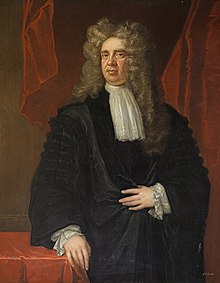Sir James Stewart (Lord Advocate)
| Sir James Stewart | |
|---|---|

Portrait of Sir James by John Baptist Medina
|
|
| Lord Advocate of Scotland | |
|
In office 1711–1713 |
|
| Preceded by | David Dalrymple, 1st Baronet |
| Succeeded by | Thomas Kennedy of Dunure |
|
In office 1692–1707 |
|
| Preceded by | John Dalrymple, Earl of Stair |
| Succeeded by | David Dalrymple, 1st Baronet |
| Personal details | |
| Born | 1635 |
| Died | 1713 |
| Nationality | Scottish |
| Spouse(s) | Agnes Traill |
| Children |
Sir James Stewart, 1st Baronet Ann Stewart |
| Parents |
Sir James Steuart Anne Hope |
| Relatives |
Sir Robert Steuart, 1st Baronet (brother) William Mure (son-in-law) Sir James Steuart-Denham (grandson) William Mure (grandson) |
Sir James Stewart or Steuart (1635–1713) was a Scottish lawyer, political opponent of the Stuarts, and reforming Lord Advocate of Scotland.
James Stewart was the fourth son of Sir James Steuart of Coltness (1608–1681), a banker in Edinburgh and Lord Provost of Edinburgh, and Anne Hope, niece of Sir Thomas Hope.
He was the brother of Sir Robert Steuart, 1st Baronet of Allanbank (1643–1707) and Sir Thomas Stewart of Coltness, 1st Baronet.
He was called to the bar on 20 November 1661, but lost almost all his practice defending his father against a charge of embezzlement.
Stewart found it necessary to leave the country because of a pamphlet, and went to Rouen, where he became a merchant under the name of Graham. Some years afterwards he returned to Scotland, but he was suspected of having had a hand in a further political pamphlet, An Account of Scotlands Grievances by reason of the Duke of Lauderdale's Ministry (1675), an order was issued for his apprehension. He escaped, and in England under the name of Lawson.
In 1678, Stewart opened a small office in London, where he gave legal advice at half fees, his clerk meeting the clients and transmitting their statements to the invisible Stewart. Returning to Scotland in 1679, he again got into trouble in 1681, when among the papers of Archibald Campbell, 9th Earl of Argyll a memorandum in his hand was found, reflecting on the government. He took refuge in The Hague. He was present at the meeting at Amsterdam in 1685, when the expedition of Argyll was resolved on.
Stewart having prepared Argyll's declaration of war, he was accused of treasonably consulting and contriving Argyll's rebellion, He was found guilty in his absence. His sentence was to be executed whenever he could be found.
Stewart was pardoned by James II of Great Britain in 1687, and returned to London. His actions have been interpreted as those of a double agent. On account of his supposed influence with the presbyterian party, he was received into favour, and employed to conduct crown cases along with George Mackenzie.
...
Wikipedia
